Contents
Ussuri plum is a popular fruit crop among gardeners in many countries of the world. It is far from whimsical to growing conditions, which greatly facilitates its care. Subject to all the necessary rules and recommendations, the gardener will certainly receive tasty and healthy fruits. A distinctive feature of the Ussuriyskaya plum variety lies in its ability to withstand extreme cold. Because of this, it is grown even in the regions of the North.
History of variety breeding
There are a huge number of varieties of Ussuri plum. And almost all of them were obtained as a result of selection of Chinese and Japanese varieties of plum fruits. One of these procedures was carried out by M. G. Isakov and N. I. Gvozdyukov. The name of the resulting plant is Selenite.
Description plum Ussuri
This variety belongs to one of the varieties of East Asian plums, which have long been valued by the inhabitants of many countries of the world. It is also called Manchurian or Chinese. The formation took place under the influence of conditions unfavorable for growth: excessive dryness in the autumn period, little snowy winters, wet and cold summers. It is especially common in the Ussuri and Khabarovsk regions.
This variety has medium fruit sizes. The height of an adult tree can reach 3 meters, which in no way affects fruiting. In any case, it will be stable and intense only with proper care. The amount of harvest, which is usually harvested from one tree, reaches 20 or more kilograms.
The crown diameter of the Ussuri plum is approximately 3-4 meters. She is shriveled up and shriveled up. The latter in shape resembles a kind of bowl, ball, or something like an elongated panicle. Homemade plum varieties are short trees that look like a swollen ball.
The ovaries are placed in groups on perennial branches. The leaf is green and smooth to the touch.
Flowering occurs only at a time when there is still no foliage on the tree. The flowers are small in size and have a white color. Near the Ussuri plum, it is necessary to plant pollinating plants, otherwise there will be no fruiting, the plum is unable to pollinate on its own. Usually the crop is harvested in the third year after planting the seedling or 6 years after planting the seed. Average life expectancy is approximately 23 years with proper care.
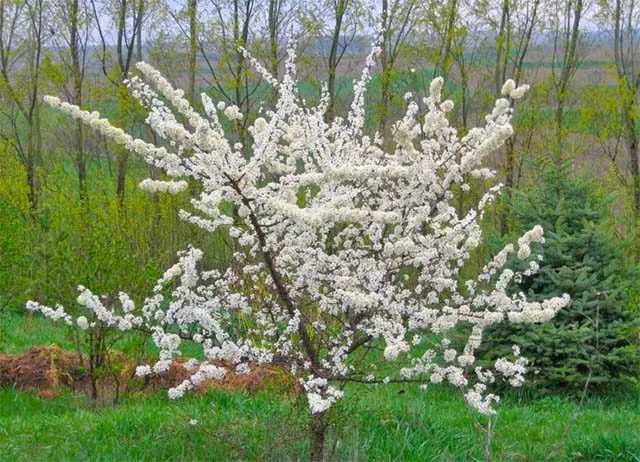
Varieties of Ussuri plum differ from each other in appearance, period of flowering and fruiting, taste. Fruit weight varies from 2 to 30 grams. The shape resembles an oblong oval, the top of which is pointed.
Almost every variety has a different color. Fruits are burgundy, lilac or yellow in color. There are also completely variegated specimens. The skin of the plum is covered with a whitish coating. Depending on the variety, the taste of the pulp also varies. Sometimes, when used, a slight bitterness can be felt.
To improve the taste and external characteristics of the plant, breeders quite often resorted to crossing different varieties. In this way, a large number of various types of Ussuri plum was obtained.
Varieties of the Ussuri plum
Especially appreciated in the northern regions of Our Country for the ability to withstand prolonged low temperatures, and for excellent taste. Ussuri plum requires pollinators.
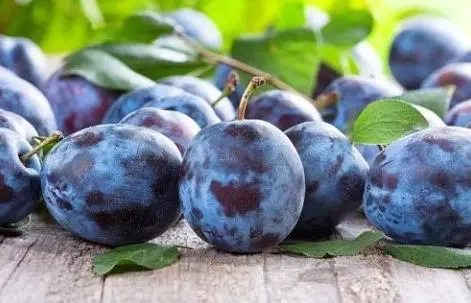
Ussuri Late
The fruits of this variety are juicy and sweet. Sometimes when consumed, a slight sourness is felt.
The ripening period is the second half of August. Fruiting is abundant and periodic. Prefers to grow in moist and clay soil, does not tolerate acidic soil. It has high frost resistance.
Vesta
Ussuri plum Vesta mid-early is ideal for growing in the cold regions of Our Country. The fruits of this variety are round in shape, with a touch of whitish or grayish hue, have a red color.
The period of full ripening is the end of summer. Fruits well. Frost resistance is high.
Covenant
The rounded fruits of the plant have a yellow color. They taste juicy and sour. It grows in regions located near the Volga. The covenant is able to withstand severe frosts. Resistant to various kinds of diseases. The variety does not like dry climates. Nearby, it is imperative to plant pollinators of the Covenant plum, namely the Chinese plum.

Golden Niva
The height of the tree of this variety is approximately 2 meters. The crown and branches form the shape of a kind of deep basket. It bears fruit every year, at the end of summer. Pollinators of the Golden Niva plum are varieties Krasny shar, Skoroplodnaya, plum.
The peel of the fruit, like the pulp, has a beautiful yellowish color, reminiscent of the color of small nectarines or apples. Tastes juicy, tender and sweet. The bone separates easily. Reviews of the Golden Niva plum are positive.
Ural prunes
The crown of the plant is quite spreading and large. The height of the tree is 1,8-2 meters. Despite its size, it bears fruit well and a lot. Plum tastes very sweet. Frost resistance is above average.
Ussuri early
The tree has a spreading crown with branches. It is often grown in regions with prolonged low temperatures. The fruits have the shape of a small ball, the flesh is yellow, fibrous. When consumed, no bitterness is felt.
Yolk
There are a lot of positive reviews about the Yolk plum on the Internet. Just like the Testament, the fruits of this variety are yellow and round in shape with a slightly flattened top. The pulp tastes sweet, juicy.
Chinese Ussuri plum variety Yolk is quite popular among many gardeners.
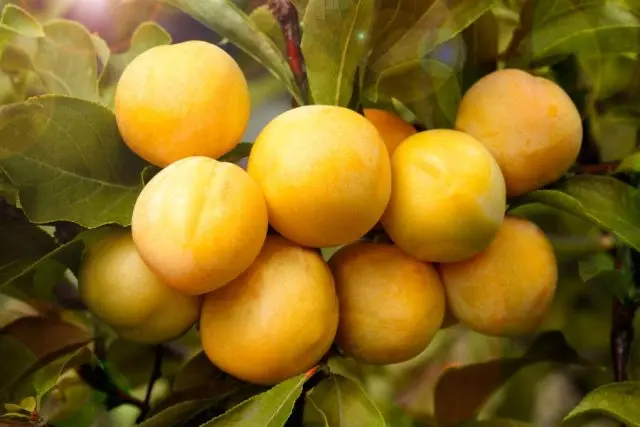
Festive
One of the most frost-resistant varieties of the Ussuri plum. It is able to withstand extremely low temperatures, down to -40ОC. The fruits are medium in size and have a beautiful yellow color. Flowering and fruiting is plentiful. From one tree, you can harvest up to 20 kilograms of the crop.
Early prunes
It has the ability to withstand severe frosts, which makes it possible to grow this variety in the regions of the North. Full ripening of the fruit occurs quite quickly. Does not tolerate highly acidic soil.
Plum contains a large amount of useful substances.
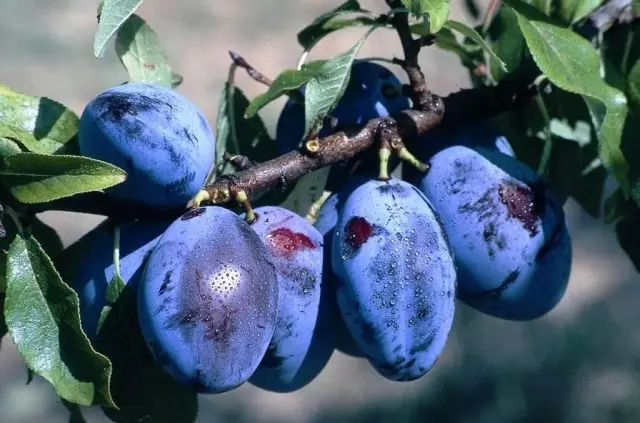
Yellow Hopts
This variety bears fruit well and abundantly. Able to withstand extreme cold. The pulp is sweet in taste, has a pleasant smell. You can not store the fruits of the Yellow Hopta for a long time, they quickly deteriorate.
Ural yellow
Plum of this variety is very often grown in the northern part of Our Country, as it has high frost resistance. The skin is easily separated from the inside. The pulp tastes sweet, juicy, has a yellow color.
The height of the tree reaches 2-3 meters. Productivity – up to 15 kilograms of berries from one tree. The fruiting period of the Ussuri yellow plum falls on August.
Snow White
The height of the tree is 2,5 meters. The crown diameter reaches 4 meters. Productivity is high, up to 30 kilograms per season. The color of the peel is pale yellow with a touch of a grayish tint. The pulp is sour.
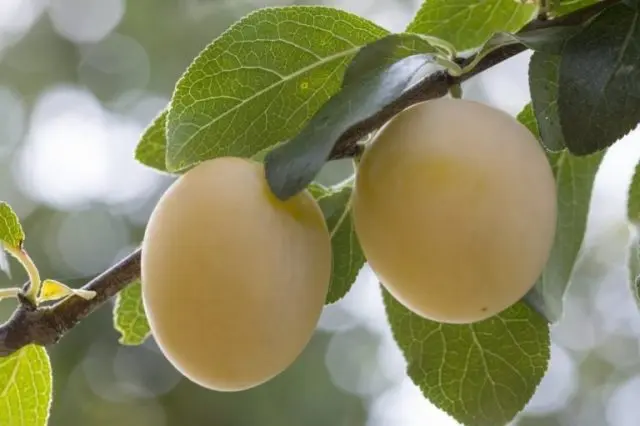
Dawn of Altai
The height of the tree can reach 2 meters. The crown does not thicken. It has the ability to withstand severe frosts. The fruits are like small balls. Plum Ussuriyskaya Zarya Altai has a red color.
Pioneer
The tree reaches 2-2,7 meters in height. The fruits are covered with a skin painted in a beautiful crimson color. Their weight is about 20 grams. The flesh is tender, juicy and very sweet.
Modest
This plum variety does not self-pollinate. That is why it is desirable to plant pollinating plants next to it, namely: another variety of the Ussuri plum. It adapts well to different types of soil.
Vika
One of the most popular varieties of the Ussuri plum. He is valued for the fact that he can withstand low temperatures, stably and intensively bears fruit. The berries are yellow, sweet and quite fragrant. Long term storage is not recommended.
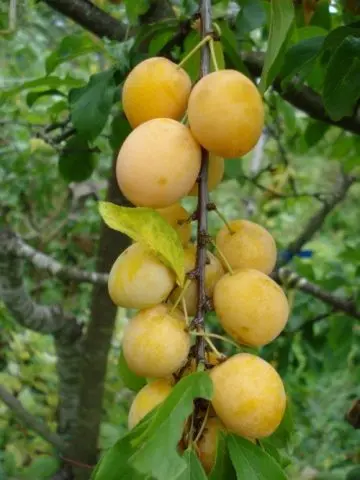
In what areas can you grow Ussuri plum
It is grown in the northern regions, where temperatures are very low, and not only. Ussuri plum is considered one of the best options for planting in such places.
Varieties of the Ussuri plum for the Urals
Most suitable varieties:
- Ural yellow.
- Ural prunes.
- Uyskaya.
- Pearl of the Urals.
- Kuyashskaya.
- Snow White.
- Eilinskaya.
- Krasnoselskaya.
- Uvelskaya.
- Pride of the Urals.
- Shershnevskaya.
Varieties of the Ussuri plum for Siberia
The following varieties take root quickly:
- Burgundy.
- Yellow Hopty.
- Altai Jubilee.
Varieties of the Ussuri plum for Buryatia
In the conditions of Buryatia take root well:
- Pioneer.
- Vika.
- Covenant.
Advantages and disadvantages of varieties
Pros | Cons |
Able to withstand low temperatures. | It blooms during a period when insects practically do not fly. |
Decorates the garden. | Does not self-pollinate. |
It is immune to many diseases. | Short-lived. |
Brings a big harvest. | It is difficult to separate the stone from the pulp, which is typical for some plum varieties. |
Features of landing
So that the plant does not die the next year, it is necessary to adhere to several important rules for planting and caring.
Recommended dates
It is best to plant plums in the spring. You can start as early as April after warming up the soil.
Choosing the right place
Plum prefers to grow in warm climates. In order for fruiting to be good and intense, the ambient temperature must be at least 8-15ОC. It is not recommended to plant a plant that does not tolerate cold well, where it is constantly frosty and strong winds blow.
What crops can and cannot be planted nearby
It is undesirable to plant hazelnuts, poplar, fir, pear, walnut crops, cherries next to the Ussuri plum. This neighborhood negatively affects both plants.
Apple trees, black currants, thyme, many flowers (daffodils, tulips) favorably coexist with plums.
Selection and preparation of planting material
Before planting a seedling, it is recommended to carefully prepare the soil. Neutral soil, rich in minerals and other useful elements, is suitable for growing plums.
It is best to choose frost-resistant varieties.
Landing algorithm
The Ussuri plum planting scheme consists in proper soil preparation and further tree care. The main thing that the gardener should remember is that the plant cannot be planted in places constantly blown by north winds and non-melting snowdrifts.
The roots will adjust to the new location on their own. They just need to provide favorable conditions for growth, planted exclusively on low mounds.
Plum Aftercare
In order for the plant to quickly adapt to new conditions, it is necessary to follow several rules. They consist in timely watering and monitoring the condition of the plum.
Diseases and pests, methods of control and prevention
Most often, the Ussuri plum suffers from codling moths, which cause severe harm to the plant. To get rid of them, in early August, special means are used: Decisom, Karbofos, Alatar.
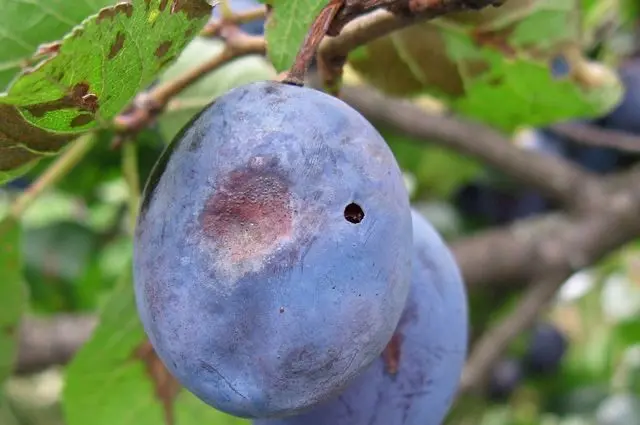
Plum varieties that do not tolerate frost well are recommended to provide the most favorable conditions for growth and plant only in warm places.
To prevent the invasion of pests, it is necessary to carefully care for the plum:
- water periodically;
- feed the tree
- cut branches every 2-3 years;
- treat the site with drugs to prevent the reproduction of pathogens.
Conclusion
Plum Ussuri is quite a popular culture among many summer residents. It is grown in the northern regions of the country. It perfectly adapts to different environmental conditions, and already for 3-4 years it begins to actively bear fruit.
For a more detailed acquaintance with the variety, the following videos are recommended for viewing:









